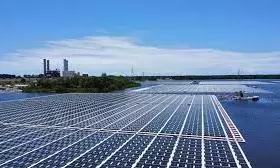India has catapulted itself to the third spot globally in solar power production, overtaking Japan, reinforcing the country's pivotal role in the renewable energy revolution. This milestone underscores India's accelerating investments, innovative policies, and massive infrastructure developments propelling solar energy to the forefront of its power generation matrix. With an installed solar capacity nearing 100 GW and a consistent growth rate, India is not only meeting its ambitious climate goals but also setting a benchmark for emerging economies worldwide.
Key Highlights of India’s Solar Power Ascendancy
India’s installed solar capacity crossed approximately 97,000 megawatts (MW) by mid-2025, marking a remarkable 33.7% increase over the previous year, positioning it as the third-largest solar market globally after China and the United States.
This surge enabled India to surpass Japan in total solar energy production, with India generating over 113 terawatt-hours (TWh) of solar electricity in 2023, compared to Japan’s 110 TWh.
The notable progress stems from large-scale solar parks such as the Bhadla Solar Park in Rajasthan (2,245 MW), Pavagada Solar Park in Karnataka (2,050 MW), and Kurnool Solar Park in Andhra Pradesh (1,000 MW), which collectively account for a significant share of India’s solar power generation.
By April 2025, India’s total renewable energy portfolio exceeded 105 GW, with solar power constituting over 90 GW, supported by aggressive government auctions, favorable tariffs, and technological advances in photovoltaic (PV) systems.
Solar power contributed to about 10% of the overall electricity generation mix during peak months in early 2025, while also contributing to a rare decline in coal and natural gas power generation during that period.
Government Initiatives Driving Solar Growth
The National Solar Mission, launched in 2010, aimed initially to achieve 20 GW by 2022 but achieved this target four years early, encapsulating the intensity of India’s solar ambitions.
The government’s updated target now aims for an ambitious 500 GW of renewable energy capacity by 2030, with solar power accounting for a major portion.
Initiatives such as accelerated capacity auctions, streamlined land acquisition policies, grid infrastructure enhancements, and public-private partnerships have catalyzed solar power plant development across diverse geographies.
State governments in Rajasthan, Gujarat, Karnataka, and Tamil Nadu have played pivotal roles by facilitating large-scale projects and encouraging rooftop solar installations.
Emerging trends include floating solar parks, hybrid solar-wind power projects, and integrated energy storage solutions enhancing grid stability and power availability.
Technological and Environmental Impact
The deployment of advanced technologies like dual-axis solar trackers, automated cleaning robots, and real-time monitoring systems has optimized the efficiency of solar parks.
This green energy revolution has significantly curbed carbon emissions, with India’s solar sector estimated to reduce CO₂ emissions by millions of tonnes annually.
The expansion of solar power has also mitigated dependence on fossil fuels, helping flatten coal consumption rates despite rising electricity demands.
Behavioral shifts in energy consumption patterns, motivated by clean power availability, have fostered sustainable development and energy security across urban and rural India.
Challenges and Future Outlook
Despite the remarkable progress, challenges such as grid integration, transmission bottlenecks, and intermittency remain.
Further investments in battery storage, smart grid technologies, and regional cooperation are essential to harness the full potential of solar energy.
The government’s commitment to supporting domestic manufacturing of solar panels and components aims to reduce import dependence and boost the ‘Make in India’ initiative.
Continued policy clarity, financial incentives, and innovation will be key to sustaining India's growth trajectory and achieving climate commitments under the Paris Agreement.
In summary, India’s surpassing of Japan to become the world's third-largest solar power producer epitomizes its growing leadership in clean energy. With a strategic blend of policy, technology, and scale, India is poised to further advance its solar capacity, fostering sustainable growth, energy independence, and environmental stewardship on the global stage.
Sources: The Environmental Blog, Reuters, LinkedIn



